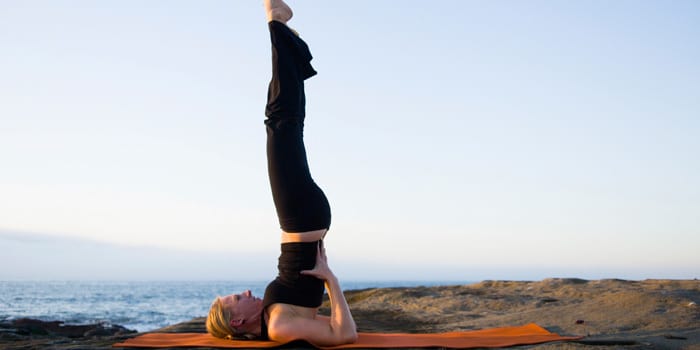How to Do a Shoulder Stand

A shoulder stand may look simple, but it requires a lot of core strength. The yoga name for a shoulder stand is Sarvangasana, meaning roughly “every body part position,” and you’ll feel how this move engages muscles throughout your whole body. It will stretch your neck and shoulders and tone your legs, buttocks, and core. Work your way into it gently. If you can’t do the move right away, try a Bridge or Plough pose instead to build the strength you’ll need to conquer a shoulder stand one day soon.
The pull of gravity affects all of the body’s organs, drawing tissues downward and pooling fluids in the lower extremities. An inverted pose like shoulder stand, which brings your heart above your head, brings temporary relief from the effects of gravity. It sends blood flow quickly and easily to your heart, which can help improve circulation, temporarily reduce blood pressure, and aid the body in eliminating waste more efficiently. Reversing the effects of gravity also relieves pressure on the digestive tract, allowing things to shift and get moving, if you know what I mean. This pose is said to stimulate the thyroid gland (located at the base of the neck), which regulates metabolism. If you feel like your metabolism is sluggish, add a shoulder stand to your fitness routine and see if you notice any improvement.
Here are some pointers for getting safely* into and out of a shoulder stand:
1. Warm up your neck and shoulders with light stretching and poses like Cat, Cow, Cobra, and Bridge.
2. Fold a thick blanket into rectangle. Lie flat on the floor with your shoulders on the blanket, so your shoulders and neck are supported and your head touches the floor. Your arms should rest on the floor at your sides.
3. Bend your knees, and bring your heels close to your buttocks. Curl your knees toward your chest, and press your hands into the floor to help you lift your hips up off the floor. Continue to curl your pelvis up and away from the floor, bringing your knees close to your face.
4. With your elbows close to your sides, place your palms on your low back for support and balance. Slowly walk your hands up your back (closer to the floor), which will help you lift your torso higher off the floor, until you are resting on your shoulders.
5. Lift your knees toward the ceiling, bringing your thighs in line with your torso. Your feet should hang near your butt. Feel that your core is strong and engaged. Don’t let your pelvis slip out of alignment with your torso and legs.
6. When you feel steady in this position, straighten your knees, making a straight line from your heels to your shoulders. Press your shoulder blades and the backs of your arms into the floor. Relax your throat and lift your upper spine away from the floor.
7. Hold the pose, breathing smoothly and evenly, for as long as you feel comfortable.
8. To release this pose, bend your knees, place your hands on the floor, bring your knees toward your forehead and then carefully roll your back onto the floor one vertebrae at a time until you return to your starting position.
*This exercise is not recommended for people with neck injuries, high blood pressure, headache, diarrhea, or during menstruation. As with all exercise, it is advised that you check with your doctor if you have health concerns.
Not quite ready for a shoulder stand? Here are some basic yoga poses you can do. Also, check out Beachbody’s 3 Week Yoga Retreat to learn the fundamentals of yoga by our very own Beachbody yoga experts.
